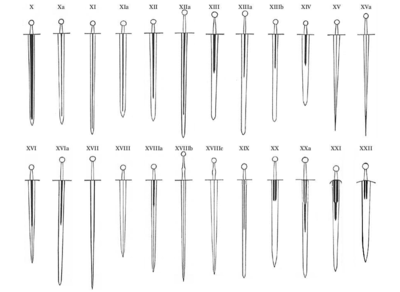
The Oakeshott typology is a way to define and catalogue the medieval sword based on physical form. It categorises the swords of the European Middle Ages (roughly 11th to 16th centuries[1]) into 13 main types, labelled X through XXII. The historian and illustrator Ewart Oakeshott introduced it in his 1960 treatise The Archaeology of Weapons: Arms and Armour from Prehistory to the Age of Chivalry.
The system is a continuation of Jan Petersen's typology of the Viking sword, which Petersen introduced in De Norske Vikingsverd ("The Norwegian Viking Swords") in 1919. In 1927, the system was simplified by R. E. M. Wheeler to only seven types, labelled I through VII. Oakeshott slightly expanded the system with two transitional types, VIII and IX, and then he started work on his own typology.
Among the many reasons for his typology, Oakeshott found date classification unreliable during his research. He wrote that the weapons' dates of manufacture, use, and retirement have been greatly obscured by trade, warfare, and other various exchanges combined with the weapons' own longevity.[1]
- ^ a b Ewart Oakeshott (1994). The Sword in the Age of Chivalry. Woodbridge: Boydell Press. p. 19. ISBN 978-0-85115-715-3. OCLC 807485557. OL 26840827M. Wikidata Q105271484.